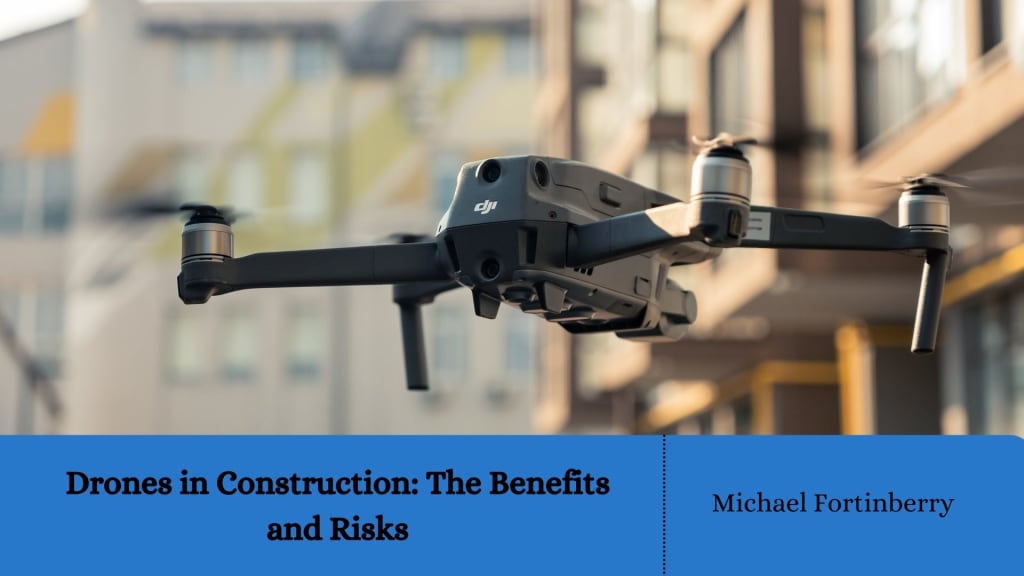Michael Fortinberry | Drones in Construction: The Benefits and Risks
Michael Fortinberry, the Co-Founder and COO of Protiv in New York City, shares the benefits and risks of using drones in construction.

Using drones in construction has become increasingly popular in recent years, with companies utilizing these uncrewed aerial vehicles (UAVs) to survey job sites, track progress, and identify potential safety hazards. While there are certainly benefits to using drones in construction, there are also some potential risks that need to be carefully considered.
The Benefits of Drones in Construction
One of the main benefits of using drones in construction is improved safety. By using drones to survey job sites and identify potential safety hazards, companies can reduce the risk of accidents and injuries. Additionally, drones can be used to monitor workers and ensure that they are following safety protocols.
Another benefit of using drones in construction is improved efficiency. Drones can quickly and accurately survey job sites, which can help companies identify potential issues and develop more effective construction plans. Additionally, drones can be used to track progress and ensure that projects are staying on schedule.
Drones can also provide a unique perspective on construction sites that can be difficult to obtain using traditional methods. By flying over job sites and capturing aerial footage, companies can better understand the site’s layout and topography, which can help develop construction plans and identify potential challenges.
The Drawbacks of Drones in Construction
However, some potential risks are associated with using drones in construction. One concern is that drones can be difficult to control, particularly in windy or inclement weather. This can lead to crashes and drone damage, which can be costly for companies.
Another concern is that drones can be used for malicious purposes. For example, drones can conduct job site surveillance or gather sensitive information about a company’s operations. Additionally, drones can be used to carry out attacks or cause damage to equipment or property.
There are also some regulatory concerns associated with using drones in construction. In many countries, drones are subject to strict regulations regarding where and how they can be flown. Additionally, companies may need special permits or licenses to use drones for commercial purposes.
Conclusion
Overall, using drones in construction presents several benefits and risks that must be considered carefully. While drones can provide valuable insights into construction sites and improve safety and efficiency, there are also potential risks associated with their use. Companies considering using drones in construction should carefully evaluate the benefits and risks and develop a plan to safely and effectively integrate drones into their operations. Additionally, companies should stay up-to-date on regulatory requirements and ensure that they are complying with all applicable laws and regulations related to drone use. By doing so, companies can reap the benefits of using drones in construction while minimizing the risks.
About Michael Fortinberry
Michael Fortinberry is the Co-Founder and COO of Protiv, a productivity program centered around managing project-based incentives. Based in New York City, Michael has had years of experience in the business world.
Protiv currently demands all of Michael Fortinberry’s attention. It was founded in October 2021 and has since worked hard to revolutionize the hourly pay system. Michael is proud of what Protiv offers, including a transformative business solution for hourly wage workers. The platform links production and compensation, transforming it from a bonus program into something far more comprehensive. Through this practice, companies will find that their employees produce quality products at a faster rate, as they are incentivized to do so. The beauty of Protiv is that it pays employees a fair price while lowering labor costs. It’s a corporation’s dream.
One might wonder how Protiv works, and Michael Fortinberry is happy to explain the process to others. Protiv allows business owners to directly link costs to production, which results in a decline in labor costs. More importantly, it empowers employees to reward themselves directly with higher compensation through their productivity. To put it another way, Protiv rewards employees with strong time management skills. It took three years of testing to get Protiv to this point, allowing the company design to evolve.
About the Creator
Michael Fortinberry
Michael Fortinberry is an innovative entrepreneur and COO of Protiv. He is also the Senior Vice President of Perennial Construction Solutions. Visit his site about technology or his site about entrepreneurship for more!






Comments
There are no comments for this story
Be the first to respond and start the conversation.